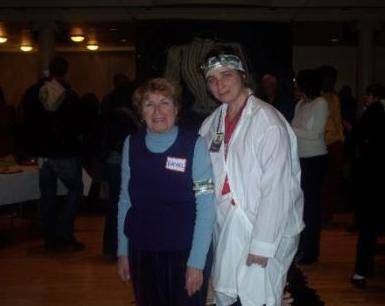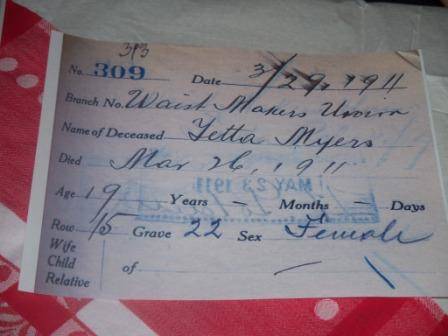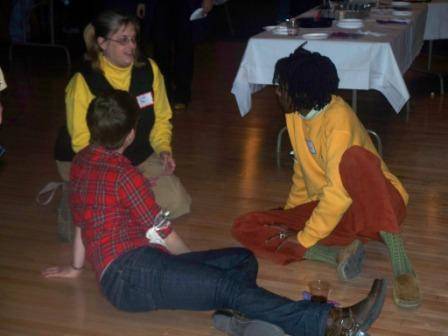Triangle Factory Fire Centennial: What to Do to Keep Memory Alive?
When you live in a European country or in America, where democracy was first conceived and institutionalized, you take the rights you have and enjoy for granted. But if you look back and investigate the history of your country you find out that there were MANY men and women who fought for these rights. Perhaps, who knows, you might also find out that these modern-time heroes were part of your own family. They won a lot of battles, giving disabled, injured, elderly people, children, and handicapped persons the rights they deserve as human beings. They did the same for women too.
American women conquered the right to be treated the same way as men, with the same opportunities, duties and possibilities they have in the year 1911, when on the March 25th the 'Triangle Factory Fire" killed 146 mainly Italian and Jewish female garment workers. Considered to be one of the largest industrial disasters in the history of the city of New York, the tragedy hit the business and the public image of the Triangle Shirtwaist Company, that at that time employed more than 600
women, mostly young Jewish or Italian immigrants. The circumstances in which they were called to work were, according to modern standards, at the very least "inhumane": fourteen-hour shifts led to 60-72 hour workweeks, with an average yearly income of 338$ (which corresponded to about half of the salary earned by their colleagues working for other companies). The conditions were so awful that in 1909 the Factory had already been at the center of many strikes, including the so-called "Uprising of 20,000" - that actually began with a spontaneous walkout at the Triangle Company. The fire in 1911 finally led to the institutionalization of Women’s Day and, more important, to the recognition of several civil and social rights and comprehensive safety and workers' compensation laws.
So, this really should be considered one of the pillars of United States' modern history. How many people, especially young students and citizens, know of these occurrences? Are we sure it is not becoming just a torn page in our infinite book of memories?
With the need and hopes of being able to answer this difficult and tricky question, on March 24 the Triangle Factory Fire coalition organized an event to commemorate the victims of the fire and to plan for the centennial (25 March 2011). The event was held at the Judson Memorial Church, Washington Square, Manhattan, and featured the presence of several members and active representatives of the coalition, including artists, actors, educators, descendents of the victims, historians and musicians. They endorsed it together with several institutions and organizations, mainly Italian. Among them,
Casa Italiana Zerilli Marimo' at NYU, the John D. Calandra Italian American Institute/Queens College, the City Reliquary Museum and Civic Organization, the Department of Romance Languages at Hunter College (CUNY), theEast Village History Project, the Education & Labor Collaborative (Adelphi), Franklin Furnace, the Gotham Center for New York City History, the Greenwich Village Society for Historic Preservation, theMALIA Collective of Italian American Women, the Street Cry Productions and the Women and the Gender Studies Program at Hunter College (CUNY).
On that evening NYC citizens of all ages and social extractions demonstrated great interest in the initiatives of the social groups participating. Each one of them had a small booth where they exposed materials about their mission and their own proposals for the centennial. Those present that evening were also freely invited to join them and contribute to the cause, and they could do it in many varied ways.
A commemorative ribbon was also donated to each person present, who knotted it around their arms, head and wrist. They also enjoyed Italian and American food, wine and beer as a refreshment while musicians and singers performed Italian, Neapolitan and American music.
Among the most inventive exhibitions was a long carpet on which 146 large round buttons represented the victims of the fire. Organizations and social groups were all invited to "adopt" one of them and represent the victims on the 2011 commemoration.
"Ruth Sergel, the founder of the coalition, had this idea that 146 organizations will each honor one fire victim. So that by 2011, we can create memorial events where every victim is honored. We needed a visual way to get people involved. I came up with the idea of "sewing buttons onto a giant shirtwaist"
as a way for organizations to sign up. Rose painted the shirtwaist. I made the buttons. My Mom Rachel helped. I had read that the victims were layed in a row at the morgue and that family members had to walk up and down looking at the bodies layed out in coffins on the floor, to try to make identifications. So, in an ephemeral ritual, I layed the buttons which were made out of paper plates, ribbons, and wool, in the same head to head pattern. When we called the names of the deceased, participants walked up and down and around, in the same way at the morgue. We called the names together, holding lace, sprinkling ribbons, reading the names in unison. It was very moving", said Annie Lanzillotto, a member of the planning committee of the Coalition. She was supported in her initiative by the before-mentioned Ruth Sergel, the promoter of CHALK, an annual community-wide commemoration of the 1911 Triangle Factory Fire, involving dozens of participants who fan out across the city to inscribe in chalk the names & ages of the victims in front of their former home.
When we asked Annie why this initiative is so important to her, she answered: "The Triangle Fire is one story of where our Italian ancestors’ American Dream ended in disaster with teenage lives cut short. The Triangle Fire is also a clear example where labor and lives were undervalued in the name of capital and this story never ends. For me, it is important to be a rememberer. I am fascinating by New York history and New York ancestors. These streets have always been mean. I want to represent the Italian lives lost."
Last week's event was just the first of several which will take place from now until 2011: the next one is scheduled for 2010, when the participating groups will gather again to further discuss the different proposals suggested and the program to be scheduled.
To join the Triangle of Fire Remembrance Coalition, support it, or participate in the organization of the 2011 Centennial, visit its official website.






































i-Italy
Facebook
Google+
This work may not be reproduced, in whole or in part, without prior written permission.
Questo lavoro non può essere riprodotto, in tutto o in parte, senza permesso scritto.